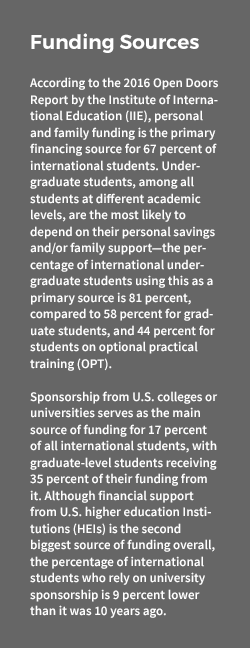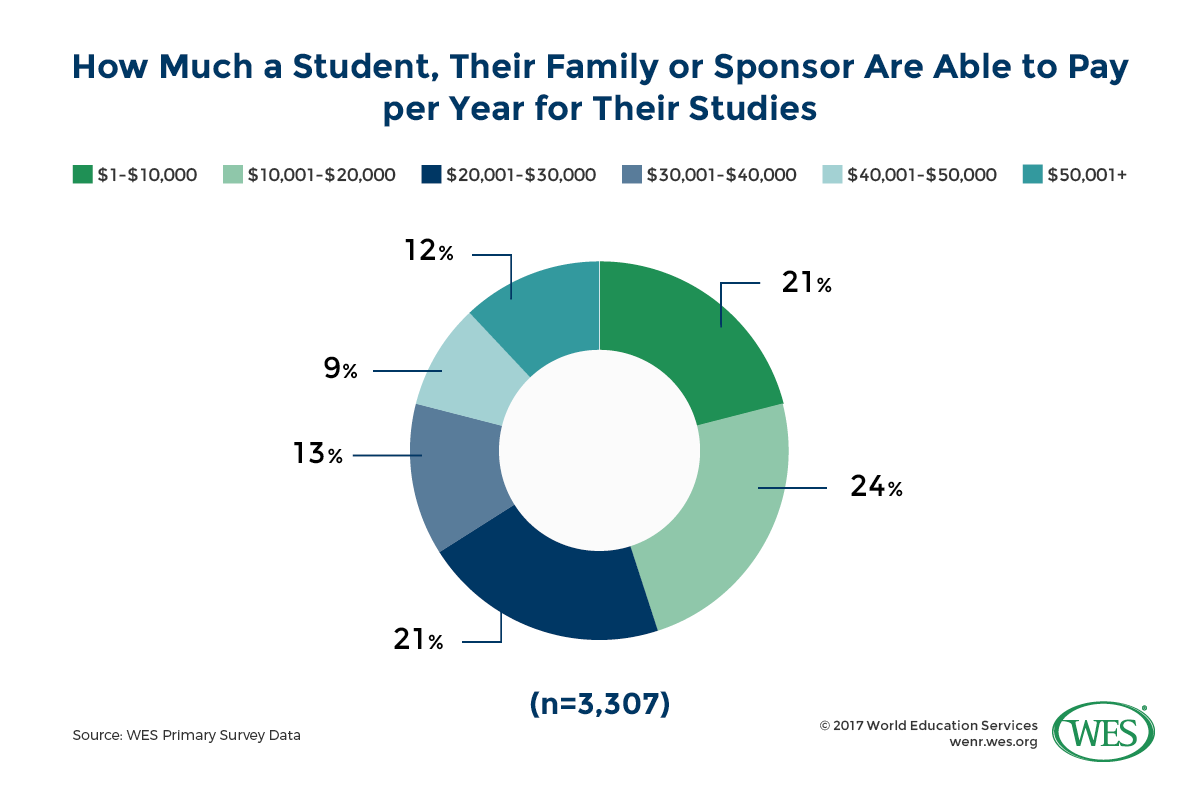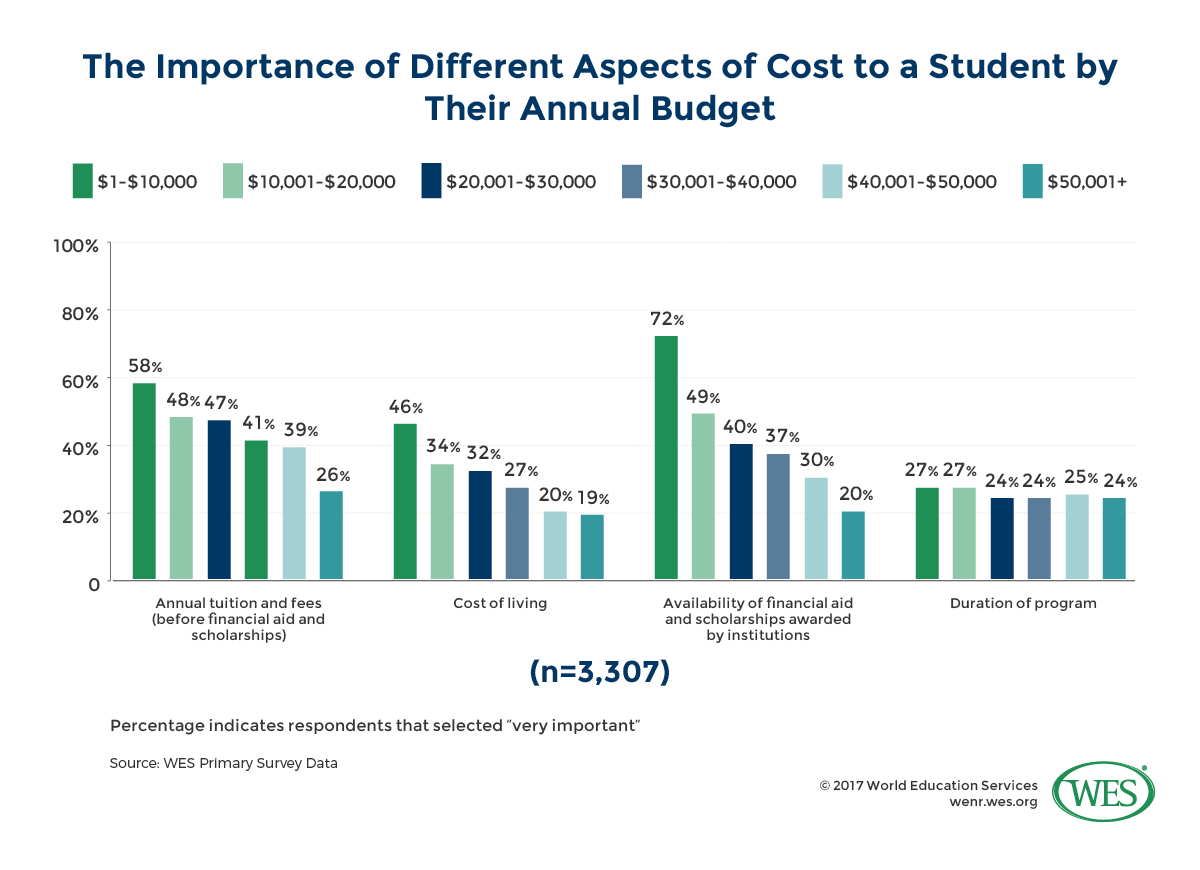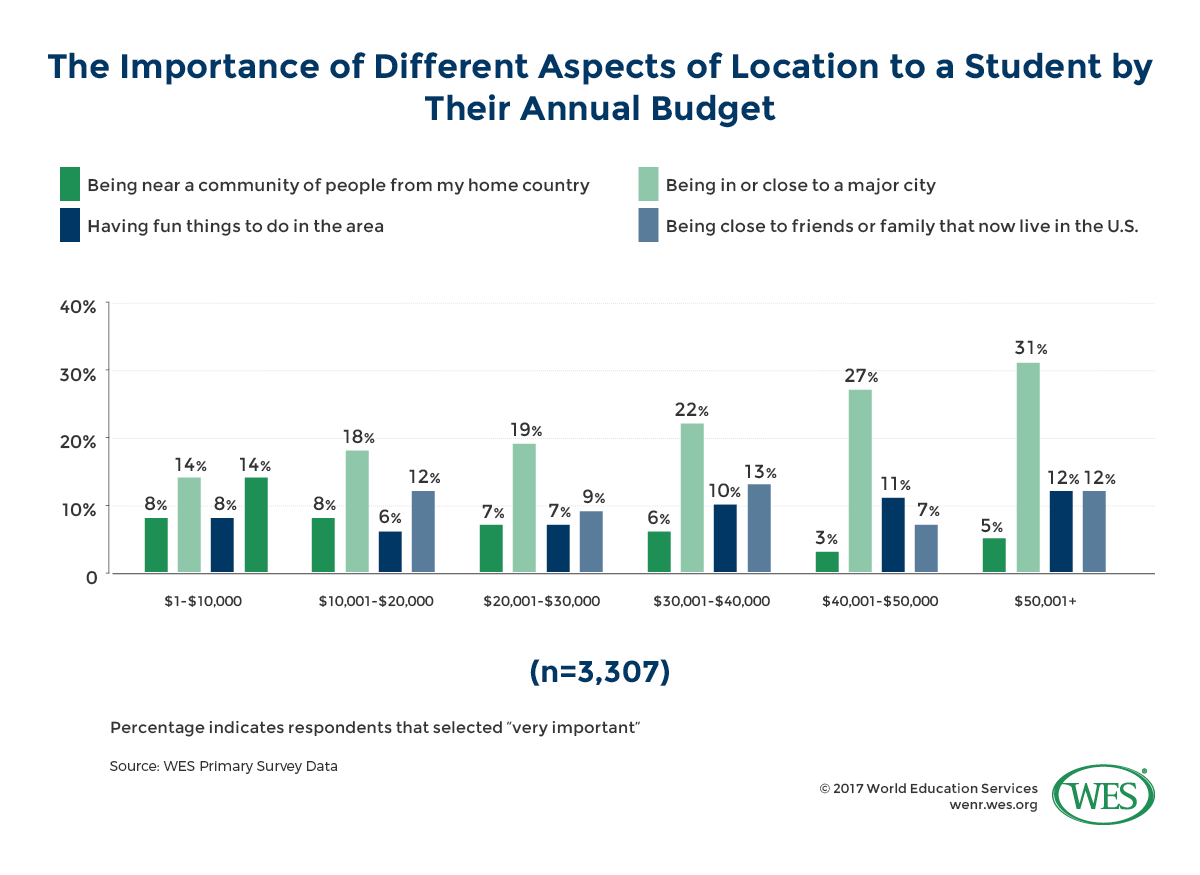Paul Schulmann, Research Manager, WES
Pursuing a degree in the U.S. is notoriously expensive for international students, who do not qualify for in-state tuition at public schools and are often recruited in part to subsidize the skyrocketing cost of higher education [1].
Higher education administrators are aware of the financial burden that international students and their families undertake in order to obtain an American degree, but insight into how specific budgeting constraints affect students’ choices is lacking.
To address this question, WES delved into survey data collected in 2015 from 3,307 international students who used WES’s credential evaluation services to pursue their education in the U.S., and for the first time, looked specifically at how students’ budgets impacted their educational choices.1 [2]
What Are Students’ Budgets?
Our research found a huge range in terms of what international students allocate towards their educations on an annual basis. Nearly as many students reported a budget of USD $10,000 or less per year as did a budget of USD $20,001 to $30,000. The takeaway is that students with vastly different economic backgrounds aspire to U.S. educations.
We did see differences in student budgets by intended degree level, years of professional experience, and fields of study. For example:
- Students who intend to study at the master’s level generally have a bigger annual budget than those at the bachelor’s level. Only 15 percent of master’s students have an annual budget of less than $10,000, compared to as many as 30 percent bachelor’s students.
- Respondents who have longer professional experience do not necessarily have a larger budget for their U.S. education. Thirty-one percent of respondents with more than 10 years of job experience have less than a $10,000 annual budget, higher than all other groups of respondents. Those without any professional experience, on the contrary, have relatively higher budgets.
- Students pursuing non-STEM majors tend to have slightly higher budgets than STEM students. Business students, particularly, have the biggest budgets—as many as 20 percent of them plan to spend at least $50,000 on their U.S. education each year.
Not surprisingly, there were notable differences by the students’ home countries and regions. Survey results suggest:
How Does Cost Factor into International Students’ Decisions?
When asked about the single most important institutional factor while applying to a U.S. HEI, “career prospects” and “school reputation” emerged as the top considerations, at 45 percent and 31 percent, respectively. However, cost became a significant consideration depending on available budget.2 [4] Among respondents with an annual budget of less than USD $10,000, for example, 29 percent said “cost” was the most important institutional attribute at 29 percent, compared to 26 percent who viewed school reputation as the top attribute. Unsurprisingly, only 3 percent of respondents with a USD $50,000+ annual budget consider “cost” as a crucial factor.
 [5]Our survey divided cost-related institutional attributes into four components (See Figure 2), and asked the respondents to evaluate the importance of each in determining whether or not to apply to a certain institution or program.
[5]Our survey divided cost-related institutional attributes into four components (See Figure 2), and asked the respondents to evaluate the importance of each in determining whether or not to apply to a certain institution or program.
- The top components that the respondents cite as “very important” are annual tuition and fees (46 percent).
- The availability of financial aid and scholarships awarded by institutions (45 percent) was a close second.
- About one-third (32 percent) of respondents consider cost of living as “very important.”
- Some 26 percent view the duration of the program as a crucial factor.
Students’ budgets also affected how they ranked different components of cost. In fact, with the exception of program duration, the importance of different components of cost declined in tandem with student budgets with remarkable consistency.
Most notable is the stark contrast for availability of financial aid and scholarships awarded by institutions:
- 72 percent of students with a budget of or under $10,000 cite this factor as “very important” compared to only 20 percent of students with a budget over $50,000.
This finding has important implications for institutions’ allocation of scholarships, since it suggests that scholarships for international students with large budgets will do little to move them in the direction of enrolling at one’s institution, while the impact of scholarships on students with less financial resources is likely decisive.
The findings also suggest that shorter degree programs, while perhaps attractive to certain students, may not have a significant impact on student decisions, at least in relation to cost. As many institutions beginning to shorten degree programs to lower overall cost, particularly for MBAs, this finding is worth researching and exploring in greater depth.
Location, cited by 8 percent of all respondents as their top priority, is another important aspect in international students’ educational decision-making. Those with the highest budgets, especially, value the location of the institution(s) twice as much as those with the lowest budgets:
- Twelve percent of respondents with annual budgets of USD $50,000+ choose “location” as the most important institutional factor, compared to 6 percent of those with annual budgets of USD $10,000 or less.
When examining how different components of an institution’s location affect students’ decision-making, important and interesting differences emerge. For instance:
- Students with a budget of over $50,000 a year are more than twice as likely to consider being in or close to a major city as “very important” as students with a budget of $10,000 or less.
- The importance of an urban location increases incrementally and consistently with a student’s budget. This finding has important implications:
- For institutions that want to increase their international enrollment, but have challenges selling students on the location of their campus, offering scholarships to international students with fewer financial resources may have a big impact on enrollment rates.
- Conversely, investing resources to attract international students of a higher socio-economic status, may prove ineffectual, and have a poor return.
- For lesser known institutions located in a major city, marketing this advantage could help yield international students with larger budgets that may not have the academic background to attend better known local institutions.
Budget also affects students’ decisions in another subtle, yet important way: It is inversely related to how many schools a student applies to. In other words, students with smaller budgets tend to apply to fewer institutions while students with large budgets apply to more. For example:
- 47 percent of students with an annual budget of USD $50,000 or more apply to one to five institutions, compared to 74 percent of students with a budget of USD $10,000 or less.
- 38 percent of high-budget students apply to 6 to 10 institutions, compared to only 14 percent of students with a budget of USD $10,000 or less.
This finding has important implications for institutions trying to increase the numbers of interested students who become applicants, and in turn, enrollees. The reasoning is simple: Students with a lower budget tend to apply to fewer institutions, in part because the associated costs are high. Waiving application fees for these students is a good strategy to induce them to apply, and with fewer institutions on their radar, a safer bet for matriculation.
Key Takeaways and Recommendations
Our survey results show that international students come to study in the U.S. with a wide range of financial resources, and that students with different budgets ranges have very different preferences in terms of their target institutions and programs.
Since financial factors play an influential role in the application and matriculation decisions of international students, we recommend that HEIs in the U.S. stay informed of international students’ financial statuses, and utilize the data to help improve international recruitment efforts. This entails not only (re-)defining target markets for international enrollment, but also developing better plans to distribute and allocate scholarships and other financial aids to those who need them.
Furthermore, understanding and communicating an institution’s unique value and position among the prospective student groups can be fundamental to building your strategies and tailoring your outreach. For example, lesser-known urban institutions that are often regarded as “safety schools” may need to increase financial aid opportunities in order to attract qualified low-budget students. They also have an opportunity to market their location to well-resourced students who may lack the academic background to attend a better known local institution.
Institutions located away from major cities, whose locations are less preferred by high-budgeted students, may want to highlight their relevant services in order to appeal to them.
Regardless of which types of students institutions target, understanding how students’ budgets impacts their decision-making is an important component to building an informed and evidence-based international recruitment and enrollment strategy.
1. [9] The survey results were originally published in: Schulmann, P., & Lu, Z. (2015, October) How Master’s Students Choose Institutions: Research on International Student Segmentation. Available at http://knowledge.wes.org/rs/317-CTM-316/images/07%20-%20HowMastesChoose%20-%20vFINAL3_081016.pdf [10]
2. [11] The survey asked respondents, “Which of the following institutional factors is most important to you when applying to a U.S. college/university?” and provided the following options: School reputation, Career prospects, Location, Cost.




